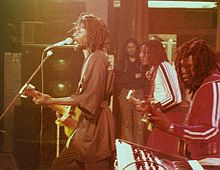Main article: Roots reggae
 Roots reggae is a spiritual type of music whose lyrics are predominantly in praise of Jah (God). Recurrent lyrical themes include poverty and resistance to government and racial oppression. Many of Bob Marley's and Peter Tosh's songs can be called roots reggae. The creative pinnacle of roots reggae was in the late 1970s[citation needed] with singers such as Burning Spear, Gregory Isaacs, Freddie McGregor, Johnny Clarke, Horace Andy, Ijahman Levi, Barrington Levy, Big Youth, and Linval Thompson, and bands like Culture, Israel Vibration, the Meditations, and Misty in Roots, teaming up with various studio producers including Lee 'Scratch' Perry and Coxsone Dodd. Musically, on the song "Roots, Rock, Reggae" Marley devised a new style of "off beat" music where a bar of six beats is played, with the guitar skanking on the fourth and sixth beat. Although entirely separate from the beats of ska, rock steady, reggae, skank, flyers, rockers and all later styles, this unique beat seems to have been so closely associated with Marley that few others adopted it.
Roots reggae is a spiritual type of music whose lyrics are predominantly in praise of Jah (God). Recurrent lyrical themes include poverty and resistance to government and racial oppression. Many of Bob Marley's and Peter Tosh's songs can be called roots reggae. The creative pinnacle of roots reggae was in the late 1970s[citation needed] with singers such as Burning Spear, Gregory Isaacs, Freddie McGregor, Johnny Clarke, Horace Andy, Ijahman Levi, Barrington Levy, Big Youth, and Linval Thompson, and bands like Culture, Israel Vibration, the Meditations, and Misty in Roots, teaming up with various studio producers including Lee 'Scratch' Perry and Coxsone Dodd. Musically, on the song "Roots, Rock, Reggae" Marley devised a new style of "off beat" music where a bar of six beats is played, with the guitar skanking on the fourth and sixth beat. Although entirely separate from the beats of ska, rock steady, reggae, skank, flyers, rockers and all later styles, this unique beat seems to have been so closely associated with Marley that few others adopted it.




